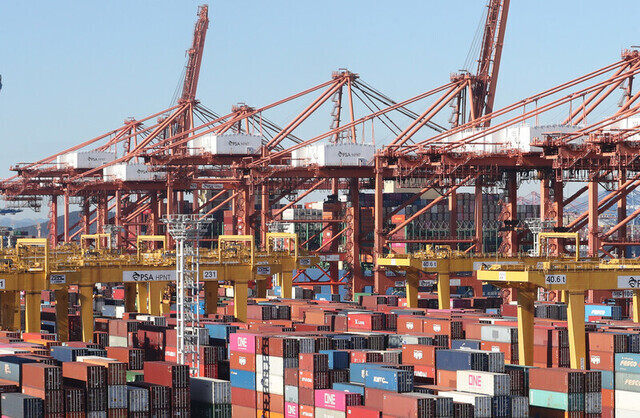hankyoreh
Links to other country sites 다른 나라 사이트 링크
S. Korea posts record-high $12.69B trade deficit for January

South Korean exports continued a four-month slide with a large drop in figures for the first month of 2023 amid a slump for semiconductors and other major items.
The balance of trade registered its biggest monthly deficit in history. With exports representing the biggest category shoring up the domestic economy, the poor performance is creating serious burdens across all areas of macroeconomic management.
On Wednesday, the Ministry of Trade, Industry and Energy (MOTIE) published a report on export and import trends for January. The report calculated exports at US$46.27 billion — down 16.6% from the same month in 2022 — while imports were down by 2.6% to US$58.96 billion.
The numbers translated into a trade deficit of US$12.69 billion — vastly surpassing the previous record monthly deficit of US$9.435 billion last year. It also amounted to 26.7% of the annual deficit of US$47.467 billion registered for last year, which was the largest ever.
The deficit in the balance of trade has continued for 11 straight months since a negative balance of US$14 million recorded in March 2022. This is the first time the balance of trade has remained negative for 11 or more months in the 26 years since the period from January 1995 to May 1997.
The MOTIE attributed the export slump in January to a sustained slowdown in the global economy due to factors including high prices and interest rates, along with a drop-off in semiconductor business conditions. It also said the scale of the decline stemmed in part from the baseline effect compared with January 2022, when exports recorded their strongest-ever performance for the first month of the year at US$55.46 billion.
Semiconductor exports remained at the level of US$6 billion, down 44.5% from the same month in 2022. They were found to be the main factor driving down overall export performance.
Automobile and rechargeable battery exports recorded their strongest performance yet for the month of January, while ship exports continued to show an increase for a second straight month. But those numbers were not enough to offset the general trend of decline in exports.
By market, exports were up in the Middle East (4.0%) and European Union (0.2%) but declined sharply in China (-31.4%) and the ASEAN region (-19.8%), where the drop in semiconductor exports showed particularly strong effects. Exports to the US were also down by 6.1%.
The decline in imports for Japan was attributed to reduced imports of raw and subsidiary materials such as semiconductors (-12.4%) and steel (-11.8%).
Energy imports, including crude oil, gas, and coal, were calculated at US$15.79 billion. That number was down from the historic January high of US$16.17 billion registered last year, but it still represented fully 26.8% of all imports.
For the past 10 years, including 2022, the dollar value of energy imports in January has averaged US$10.3 billion.
The MOTIE is undertaking an emergency review. On Wednesday, South Korean Minister for Trade Ahn Duk-geun spoke at the first 2023 export situation review meeting, which was held at the offices of the Korea Trade Insurance Corporation (K-SURE) in Seoul’s Jongno District with representatives from export support agencies and major industry associations representing areas such as semiconductors, automobiles, oil refining, and steel.
In his remarks, Ahn predicted that “difficulties in export conditions will continue for the time being amid the effects of the global economic slowdown and the ongoing trend of falling semiconductor prices.”
By Kim Young-bae, senior staff writer
Please direct questions or comments to [english@hani.co.kr]

Editorial・opinion
![[Column] The state is back — but is it in business? [Column] The state is back — but is it in business?](https://flexible.img.hani.co.kr/flexible/normal/500/300/imgdb/original/2024/0506/8217149564092725.jpg) [Column] The state is back — but is it in business?
[Column] The state is back — but is it in business?![[Column] Life on our Trisolaris [Column] Life on our Trisolaris](https://flexible.img.hani.co.kr/flexible/normal/500/300/imgdb/original/2024/0505/4817148682278544.jpg) [Column] Life on our Trisolaris
[Column] Life on our Trisolaris- [Editorial] Penalties for airing allegations against Korea’s first lady endanger free press
- [Editorial] Yoon must halt procurement of SM-3 interceptor missiles
- [Guest essay] Maybe Korea’s rapid population decline is an opportunity, not a crisis
- [Column] Can Yoon steer diplomacy with Russia, China back on track?
- [Column] Season 2 of special prosecutor probe may be coming to Korea soon
- [Column] Park Geun-hye déjà vu in Yoon Suk-yeol
- [Editorial] New weight of N. Korea’s nuclear threats makes dialogue all the more urgent
- [Guest essay] The real reason Korea’s new right wants to dub Rhee a founding father
Most viewed articles
- 1[Column] Why Korea’s hard right is fated to lose
- 2Amid US-China clash, Korea must remember its failures in the 19th century, advises scholar
- 3[Column] The state is back — but is it in business?
- 460% of young Koreans see no need to have kids after marriage
- 5Trump’s talk of flouting NATO promises sparks apprehension in Seoul
- 6[Column] Can Yoon steer diplomacy with Russia, China back on track?
- 7[Guest essay] Maybe Korea’s rapid population decline is an opportunity, not a crisis
- 8South Korea officially an aged society just 17 years after becoming aging society
- 9[Guest essay] The real reason Korea’s new right wants to dub Rhee a founding father
- 10AI is catching up with humans at a ‘shocking’ rate